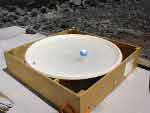More than two years after road access and electrical power to the Mauna Loa Observatory was cut off by lava flows, NOAA staff continue to make critical measurements of the atmosphere and other environmental variables at the remote site.
In 2023, observatory staff installed solar panels at the site and resumed some measurements, including the independent carbon dioxide monitoring programs run by the Global Monitoring Laboratory and Scripps Institution of Oceanography, as well as other atmospheric measurements.
Construction of a temporary road to access the observatory site is anticipated to begin in summer 2025.
Media can contact: Theo Stein (303) 819-7409 (theo.stein@noaa.gov)
Organization(s):
 National Aeronautics and Space Administration (NASA)
National Aeronautics and Space Administration (NASA)
 California Institute of Technology (Cal Tech)
California Institute of Technology (Cal Tech)
What does this program measure?
Isotopes of Helium; Helium 3 and 4. Units of measure: mol/gramme
How does this program work?
Noble gas Mass spectrometry Analysis of Magnetically separated cosmic dust particles.
Why is this research important?
To measure Temporal Variability of Inter-Planetary Dust Particles (IDPs) influx.
Are there any trends in the data?
Yes, Periodic enrichment and depletion of helium 3 isotope.
How does this program fit into the big picture?
What is it's role in global climate change?
Understanding the IDP influx allows us to quantify time scales of major climatic events in Earth's history
Comments and References
This project is no longer active.
Lead Investigator(s):
Prof. Kenneth A. Farley
626-395-6005
MLO Contact(s):
Dr. John E Barnes
808-933-6965 (x222)
Web Site(s)
not applicable
Date Started
1998
RETIRED

